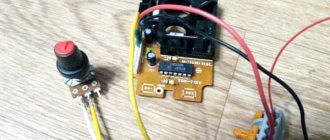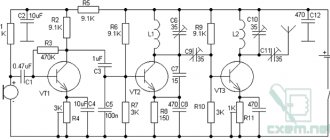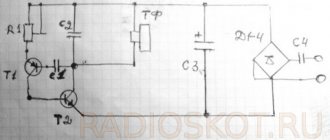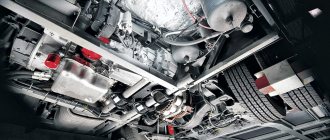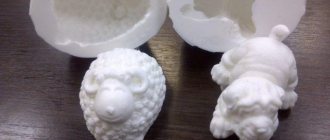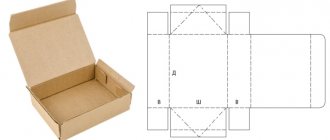So, what else can you do using the assembled Brovin kacher?
What you should not do is bring cameras, phones or other gadgets near it. There is a powerful electromagnetic field around the camera, so any electronics that fall into it can burn out. If you want to make sure of this, the easiest way is to bring a light bulb into the field. It is best to take an energy-saving lamp. It begins to glow no worse than if it were plugged into an outlet. If you have a fluorescent lamp at home, you can add it to the field - the effect will be about the same. If you take a regular incandescent lamp, it will glow differently than usual. The glow appears colored - most of all orange and purple. It looks like a magic ball that you have probably seen in gift shops or souvenir shops. If you have a quartz resonator, you can see a rather interesting glow effect.
It is difficult to find practical application for such a device as the powerful Brovin Kacher. In fact, I assembled the kacher solely as an experiment. Other enthusiasts are usually guided by the same reason. Perhaps you will find some more useful use for the assembled kacher. If you succeed, be sure to share with us your build option and how you can benefit from this interesting device.
Write comments, additions to the article, maybe I missed something. Take a look at the site map, I will be glad if you find anything else useful on my site.
Areas of use
The widespread practical application of new devices and products operating on the basis of this new physical phenomenon will make it possible to obtain a very significant economic, scientific and technical effect in various spheres and areas of human activity.
Let's consider the areas of application of this device:
1. New relays and magnetic starters based on the widespread use of kacher technology:
- can lead to a reduction in energy costs and an increase in production efficiency in general, which together will provide a very significant economic effect in the country’s economy;
2. Devices that illuminate fluorescent lamps (fluorescent lamps) not from 220 V, as now, but using KACHER technology products, from a supply voltage of 5 to 10 V:
- this will significantly reduce the level of fire and explosion hazards
3. Devices that provide the possibility of not serial (currently used), but parallel connection of individual solar battery elements:
- will significantly increase the reliability, durability and efficiency of their operation, as well as obtain a significant economic effect from their use;
4. Devices for inductive transmission of control information and energy between different traffic lights located on different sides of the intersection and included in one traffic light object (without the use of electrical wires currently used for this, with large labor costs for their installation):
- will save energy and costs.
Description of the electrical circuit assembly
DIY search magnet
The author of the invention recommends using a bipolar transistor KT902A or KT805AM (however, you can assemble a Brovin kacher on a field-effect transistor). The semiconductor element must be mounted on a powerful radiator, having previously been lubricated with thermal conductive paste. You can additionally install a cooler. It is permissible to use constant resistors, and exclude capacitor C1 altogether. First, you should wind the primary winding with a wire of 1 mm (4 turns), then the secondary winding with a wire no thicker than 0.3 mm. The winding is wound tightly turn to turn. To do this, we attach its end to the beginning of the pipe and begin to wind it, coating the wire with PVA glue every 20 mm. It is enough to make 800 turns. We fix the end and solder an insulated conductor to it
The windings should be wound in one direction, it is important that they do not touch. Next, you need to solder a sewing needle into the upper part of the pipe and solder the end of the winding to it
Next, we solder the electrical circuit and place it together with the radiator inside the plastic pipe. This elementary device is Brovin’s kacher.
Switching power supply and power switch
In order to make the assembled Brovin network camera more mobile, it is better to install a connector in the case that allows you to connect a wire from the power supply to it. Surely, almost everyone has broken equipment in their closet or garage, from which such a nest can be dismantled. If not, then it can be purchased at any radio electronics store; the cost of such goods is low.
The connector also needs to be fixed in the body of the soap dish, for which a slot was made at the end according to the dimensions.
This is how the connector for connecting the power supply was neatly placed
After the wires were soldered to the connector contacts, the socket was also fixed with hot glue. Now there was no need to be afraid that when the plug was pulled out, the connector would fall out.
We fix the power connector in the body of the soap dish
Connecting power through a switch to a transformer
Next you should be very careful. We solder the negative wire coming from the power connector to the emitter (the left contact of the bipolar transistor). You cannot mix it up here, otherwise the assembled Brovin network camera will not work.
Connect the negative power wire to the emitter
The positive wire goes directly to one of the toggle switch contacts. I didn’t take a photo of this step, everything should be clear here. And from the second contact of the toggle switch, the jumper will go to the contact of the film capacitor, which is connected through a 2.2 kOhm resistor to the base of the bipolar resistor (right contact).
We connect the second contact of the switch to the base of the transistor through a resistor
All that remains is to solder the end of the secondary winding that goes into the housing, and you can move on to the primary. We connect it directly to the base of the bipolar transistor, bypassing the resistor. In fact, the scheme is elementary and understandable even to a middle school student. Of course, such a simple device will not be capable of producing long lightning bolts, but even the minimum with such a simple scheme can already be called progress for a beginner.
Solder the end of the secondary winding to the base of the bipolar transistor
Connecting the primary winding of the transformer
Here you need to prepare two pieces of wire. At one end of each of them there should be an alligator clip for easy connection. One of the wires is soldered to the output contact of the toggle switch. Color coding does not play a role here. The fact is that if all the elements are functioning normally, the winding of the coils is done in one direction, and the Brovin kacher still does not work, then the only step to correct the defect will be to replace the polarity of the voltage supply to the primary of the transformer. In other words, it is possible that the crocodiles will have to be swapped.
Using a wire with a crocodile we connect the output contact of the toggle switch and one of the ends of the primary winding
The second alligator wire will connect the other end of the winding and the middle terminal of the bipolar transistor, called the collector.
The second wire will connect the remaining end of the primary winding to the collector of the bipolar transistor
All that remains is to assemble the Brovin Kacher we installed and begin testing its performance.
This is such a neat kacher we got
Signs that the Brovin kacher is functioning
How to check and repair an electric motor commutator yourself
After applying power to the transformer, it is better to dim the light - this way the effect will be better visible. At the tip of the secondary winding left outside, you can see a small bluish light. If you bring ordinary CFLs (energy-saving or fluorescent lamps) to the transformer, they will begin to glow without any connection.
This is the effect that kacher has on CFLs and conventional fluorescent lamps
A discharge will occur in the incandescent lamp, which is also quite interesting.
And this is how an incandescent lamp behaves next to a Brovin quality driver
Moreover, if you bring a neon lamp to the transformer, the glow will be much brighter. But the most interesting thing is that as soon as you press paper against the tip of the secondary winding, it lights up almost instantly. That is why you should not put your fingers near it. Naturally, a person will not feel an electric shock, but it is quite possible to get skin burns.
The paper flashes from the discharge quite quickly
What is a Tesla coil and why is it needed?
How to make a transformer with your own hands?
As noted earlier, a Tesla coil is a resonant transformer. The purpose of a transformer is to change the voltage value of an electric current. These devices are respectively lowering and increasing.
Read more about transformers, their general structure and purpose in our separate material.
From an electronics point of view, a Tesla coil consists of two windings without a common core and with a different number of turns. Tesla transformer is a step-up transformer. The voltage at the output of such a transformer increases hundreds of times and can reach values of the order of a million volts.
Tesla's invention not only works, but works very spectacularly. By turning on the transformer, you can observe spectacular discharges (lightning), the length of which reaches several meters.
A simple kacher circuit
Below you see the simplest, but very powerful caching scheme. It is known to every experienced electronics engineer, and even a beginner can assemble it.
Kacher includes three component modules:
- Directly the pitcher himself;
- Power supply;
- Breaker or control unit.
A chopper is needed to regulate the pulse frequency. The pulses arrive at the pnp semiconductor, which opens/closes the pn junction, “listening to the clock” of these pulses. During this seemingly extremely short time, a spark manages to run across the terminal.
In other words, the operation of the device is described as follows:
- In two directions, the current flows to the PNP semiconductor and then to the breaker;
- Voltage occurs in the power source circuit;
- The chopper is activated and sends a pulse to the transistor gate;
- The gate of the semiconductor opens the pn junction;
- Current flows through the kacher circuit;
- The circuit is closed.
Preface
This spring, I was faced with the task of creating a set of generators to test the stability of equipment under conditions of strong electrical discharges. In addition to the transistor-based HF generators that are familiar to me, which provide good HF field strength nearby, I needed a small high-voltage source. This is where I remembered the quality device of the Soviet radio engineer Vladimir Ilyich Brovin - a simple device that allows me to get the high voltage I need. I assembled my first kacher back in the early 2000s. It was a fairly powerful device almost one meter high, producing a dense beam of corona discharges. It was a dangerous thing... Hair began to move a couple of meters from it... But now I need a compact, small coil that is safe to use. After examining the materials and parts I had, I got to work.
What does a Tesla coil consist of?
Before assembling the Tesla coil, let's look at its components and shape.
Tesla coil structure
Toroidal figures: what are they?
The Tesla coil is made in the shape of a Torus (toroidal figure, toroid).
It's better to look once than to try to imagine. The figure below shows toroidal surfaces.
This is what a classic toroidal figure looks like
The toroid is an important component of the Tesla coil and is usually made of aluminum corrugation. As part of this device, it performs the following functions:
- reduces the resonant frequency;
- accumulates energy before streamer formation;
- creates an electrostatic field that repels the streamer from the secondary winding of the transformer.
By the way, you can read about what a streamer is in our separate article on lightning.
You can't help but notice the funny play on words. In Norse mythology, Thor is the god of thunder and lightning. The component of a Tesla coil, due to which a discharge (lightning) is formed, is a torus, or toroid.
Secondary winding
The secondary winding is the main component of the Tesla coil, which is also simply called the “secondary”. The winding, as a rule, contains about 800-1200 turns, and it is wound on PVC pipes, which can be bought at a regular hardware store.
Based on the required number of turns, the diameter of the winding wire is selected. The standard ratio of the length of the secondary winding of the coil to its diameter is 4:1 or 5:1. To prevent the coils from spreading, they are coated with varnish.
Primary winding and protective ring
The primary winding (or primary) of a Tesla coil must have low resistance because it will carry a lot of current. It is usually made from wires with a cross-section of more than 6 millimeters. Also, copper pipe for air conditioners is often used as the primary winding.
The shape of the primary winding is cylindrical, flat or conical.
The protective ring is an open flat turn of grounded copper wire. The ring is installed so that the toroid streamer, once in the primary winding, does not damage the electronics.
How to assemble a Brovin kacher with your own hands
If, after reading the article, you are interested in this device, you can assemble it yourself. The device is so simple that even a novice radio amateur can make it. The Brovin Kacher (diagram shown below) is powered by a modified 12 V, 2 A network adapter and consumes 20 W. It converts an electrical signal into a 1 MHz field with an efficiency of 90%. For assembly we need a plastic pipe 80x200 mm. The primary and secondary windings of the resonator will be wound on it. The entire electronic part of the device is located in the middle of this pipe. This circuit is completely stable, it can work for hundreds of hours without interruption. The self-powered Brovin Kacher is interesting in that it is capable of lighting unconnected neon lamps at a distance of up to 70 cm. It is a wonderful demonstration device for a school or university laboratory, as well as a tabletop device for entertaining guests or performing magic tricks.
Scientists shrug their shoulders
The above description of the device and the principle of its operation (and this is visible visually) contradict traditional science. The inventor himself openly demonstrates these contradictions; he asks everyone to work together to understand the paradoxical measurements of the parameters of his device. However, the position of openness on this issue has not yet led to any results; scientists cannot explain the physical processes in the semiconductor.
The concept of ether and Tesla's ideas
Now we know what a Tesla coil consists of. But what is the history of this invention? To answer this question, it is worth understanding what ether is.
At the moment, the theory of the ether is not used in modern physics, since after the advent of the theory of relativity, the need for the concept of “ether” simply disappeared.
However, new views on the concept of ether are emerging, and it should not be completely written off. Many scientists are still debating whether ether exists or not, and a new section has even appeared in physics that studies this issue (ether dynamics).
Nikola Tesla proved the existence of ether with his experiments. The scientist had an idea to use ether as a source of energy. Thus, Tesla wanted to abandon wired transmission of energy and transmit electricity throughout the world wirelessly through the ether. To do this, it was planned to install two giant coils at the Earth's poles.
Unfortunately, the direction Tesla chose was not developed at a deeper level. In addition, he was considered a strange scientist who never wanted to take the path of seeking the economic benefits of his research. In addition, another era was coming - the time of vacuum inventions.
Many of Tesla's archives were lost under mysterious circumstances. Even if Tesla found out how to obtain a practically inexhaustible source of energy, this information is not available now. The rare genius of Tesla was ahead of his time, and the world was simply not ready for his ideas.
Introduction
At least once in our lives, we hear on TV or on the Internet about the great genius Nikola Tesla and his coil, which can transmit electricity through the air.
But no one thought that at home you could assemble a similar device called the Brovin Kacher. In my work I want to show how you can use electrical appliances that are not connected to the network, and I will prove that this can be done at home without much expense. The relevance of the topic is due to the fact that the problem of finding clean energy in the 21st century is acute. In the modern world, humanity needs electricity every day. It is needed both by large enterprises and in everyday life. A lot of money is spent on its production. And that's why electricity bills are rising every year.
Object of study: physical phenomenon of contactless energy transfer.
Subject of research: a device that is capable of transmitting electricity without wires.
Hypothesis: Brovin's Kacher can be assembled at home at minimal cost.
Goal: to produce a working model of the Brovin Kacher and consider the possibilities of its practical application.
Tasks:
- study reference and scientific literature on this topic;
- consider the device, principle of operation and application of the Brovin kacher;
- create a working model of the Brovin quality player;
- analyze the knowledge gained on this topic.
Research methods:
- working with methodological literature
- comparative analysis
- observation
- experiment
By-effect
An analysis of the properties of the assembled circuit revealed some inconsistencies in its operation with generally accepted concepts. It turned out that the signals received at the electrodes of the semiconductor transistor, measured with an oscilloscope relative to the positive and negative poles of the voltage source, always had the same polarity. So, the npn transistor produced a positive signal at the collector, and pnp - a negative one. It is this effect that makes Brovin’s kacher interesting. The device circuit contains inductance, which during operation of the device has a resistance close to zero. The generator continues to operate even when a powerful permanent magnet approaches the core. The magnet saturates the core, as a result the blocking process must stop due to the cessation of transformation in the feedback circuit of the circuit. At the same time, no hysteresis was detected in the core; it could not be detected using Lissajous figures. The amplitude of the pulses at the collector of the transistor turned out to be five times higher than the voltage of the power source.
Device setup
A correctly and carefully assembled generator from serviceable components almost always starts working. To obtain the maximum voltage, you can try to change the position and number of turns of the L1 coil, focusing on the size of the streamer and the current consumed. In my case, with a supply voltage of 24 volts, the coil consumes 0.85 A. For my task, this is optimal. In some cases, it may be necessary to select resistors in the base circuit.
High voltage streamer at the end of the needle
Since my streamer is not very large, to visually indicate the operation of the coil and the presence of high voltage, I added a small neon light bulb to the body of the coil.
Neon lamp to indicate the operation of the Brovin driver
Where should I put it all?
The eternal problem is a good body. Despite a couple of computer power supplies in which some install such circuits, I decided not to use metal. For better electrical safety. After all, we’re not assembling a flashing light!
After some thought, I took as a basis a piece of plastic pipe 120x200 mm, from a kitchen hood. It's round and looks good. It will contain a circuit, a field-effect transistor with a radiator, and a primary circuit. And a secondary with a sharp copper knob will stick out from above.
The top of the case is closed with a lid from a box in which seaweed is sold.
A slot is made in the lid for the coil, and so that they do not look inside, it is covered with black self-adhesive tape.
The coils were attached to the body through a fiberboard strip left over from the renovation of the balcony, with mounting posts for connecting the three necessary wires.
When designing, keep in mind that the radiator for the transistor requires more than a pack of cigarettes; a small one will get very hot, so you won’t run the heater for a long time. I stopped at 50x100x5 mm, but after 10 minutes it becomes hot.
The second most important thing, after the coil, is the choke. A lot depends on him
A choke inductance of more than 1 Henry and a current of 1 ampere are required. I tried primary ones from network transformers: up to 50 watts it doesn’t work at all, 50-100 watts is good, 100-200 is excellent. It was just a pity to install such powerful ones, so I limited myself to the 60-watt TN42.
We place everything in a case on a metal base, to which a choke, a radiator, and, if anyone wants, a printed circuit board are screwed. I didn’t make it - I assembled it by hanging it.
The outside of the body is also covered with self-adhesive tape, and the coil is wrapped with black electrical tape. I was afraid that it would work poorly with her, but it worked out.
After placing it in the case, we turn it on again not directly to 220V, but through a fuse lamp. There may be no sparks with it, but the rumbling of the circuit and the glow of the neon light near the coil will tell you that everything is all right.
Unknown capabilities of semiconductor elements
Brovin's kacher is a type of generator assembled on a single transistor and operating, according to the inventor, in abnormal mode. The device exhibits mysterious properties that date back to the research of Nikola Tesla. They do not fit into any of the modern theories of electromagnetism. Apparently, Brovin's kacher is a kind of semiconductor spark gap in which the discharge of electric current passes through the crystalline base of the transistor, bypassing the stage of formation of an electric arc (plasma). The most interesting thing about the operation of the device is that after a breakdown, the transistor crystal is completely restored. This is explained by the fact that the operation of the device is based on reversible avalanche breakdown, in contrast to thermal breakdown, which is irreversible for a semiconductor. However, only indirect statements are given as evidence of this mode of operation of the transistor. No one, except the inventor himself, has studied the operation of the transistor in the described device in detail. So these are just assumptions by Brovin himself. So, for example, to confirm the “black” mode of operation of the device, the inventor cites the following fact: they say, no matter what polarity the oscilloscope is connected to the device, the polarity of the pulses shown by it will always be positive.
Maybe kacher is a type of blocking generator?
There is also such a version. After all, the electrical circuit of the device strongly resembles an electrical pulse generator. Nevertheless, the author of the invention emphasizes that his device has a non-obvious difference from the proposed circuits. It provides an alternative explanation for the occurrence of physical processes inside the transistor. In a blocking oscillator, the semiconductor periodically opens as a result of the flow of electric current through the feedback coil of the base circuit. In quality, the transistor must be constantly closed in a so-called non-obvious way (since the creation of an electromotive force in the feedback coil connected to the base circuit of the semiconductor can still open it). In this case, the current generated by the accumulation of electrical charges in the base zone for further discharge, at the moment the threshold voltage value is exceeded, creates an avalanche breakdown. However, the transistors used by Brovin are not designed to operate in avalanche mode. A special series of semiconductors has been designed for this purpose. According to the inventor, it is possible to use not only bipolar transistors, but also field-effect and radio tubes, despite the fact that they have fundamentally different physics of operation. This forces us to focus not on research on the transistor itself in the quality, but on the specific pulse mode of operation of the entire circuit. In fact, Nikola Tesla was engaged in these studies.
How to make a kacher with your own hands
which is understandable and simple even for a beginner, kacher can become your “entrance ticket” to the fascinating world of radio electronics (if, of course, you are not already doing such homemade products).
What you need to prepare to assemble the device:
- Two arms. Maybe even not very experienced ones, a little “crooked”;
- Wire with a cross section of 0.25 mm. It is fashionable to take wire from the transformer secondary winding;
- PNP type transistor. (KT902-A, KT805-AM, KT808, KT805-B, etc.);
- Several resistors with any resistance;
- Electrolytic capacitor 1,000-10,000 μF;
- Power supply for 12-30 V, with a current in the range of 1-1.5 A.
More information about the radio components used
The above “set” is standard. Moreover, if suddenly you don’t have any radio element on hand, you can always replace it with another one. The main thing is not to exceed the limit of 10-30% of each denomination. The generator must operate within 150 Hz.
The power supply voltage of the camera is 220 V. To protect the device, it is recommended to use a 5 A fuse. The device operates from 310 V, so we need to include a 500 V and 10 A diode bridge in the circuit. A second bridge is installed in front of the breaker - 50 V and 1 A If you are replacing a transistor, choose a more powerful one. The capacitor circuit will need to be adjusted yourself, but the best option is 0.5-1 µF.
Regarding the coil. It requires two wires. The primary coil is wrapped with 2 squares of wire, with a minimum number of turns (3-5). The secondary winding is implemented using PLSHO wire or similar. The number of turns is about 1,000. The wire can be secured with tape, but it is better with glue.
The trimming resistor for the quality device must be selected at 15-40 Ohms. If you can’t find this radio component, take a regular resistor with a resistance within the same limits.
Let's start assembling the camera
First you need to assemble the primary coil. To do this, we prepare a PVC or cardboard pipe with a diameter of 5-8 cm, and a copper wire with the largest cross-section. Further:
We form 4 turns on the pipe
It is important to make them not very dense; We take out the pipe and carefully stretch the wire so that the height of the winding is 10-15 cm. We make the secondary coil 3 times higher
For this you need to take a thin wire. The number of turns is about a thousand. To prevent the wire from getting tangled on the rod, in some places you need to coat the wires with glue or varnish. We mount the first coil around the second coil. Each of the windings should “look” in the same direction
We make the secondary coil 3 times higher. For this you need to take a thin wire. The number of turns is about a thousand. To prevent the wire from getting tangled on the rod, in some places you need to coat the wires with glue or varnish. We mount the first coil around the second coil. Each of the windings should “look” in the same direction.
The wound pipe must stand strictly vertically. It must be fixed on a horizontal stand. For example, on any durable wooden surface. Next, you need to assemble all the other radio elements according to the diagram. After assembly, you need to check the connection diagram.
If the cacher does not work
If the device does not work the first time, you need to swap the contacts of the primary coil. If this does not work, we check the transistor, then test the conductivity of the coils.
You don’t have to be afraid and change the number of turns or position on the primary coil. This must be done until there is a noticeable effect. These are all problems that can arise.
Settings
To adjust the quality, we have a tuning resistor R1 (or several constants, with different resistances). It is worth installing copper radiators on the transistors so that during operation they do not get too hot and eventually burn out.
Scheme of the driver from Brovin
The second scheme is proposed by the inventor himself. Here she is:
Here 2-3 coils and a wide variety of transistors can be used. The device is powered by a 1.2 V battery. The coils have a diameter of 5 cm. The number of turns on coils 1 and 3 is 60, on coils 2 – 30. Transistors used: 9018, 9014, KT315, etc.
To achieve the greatest effect with such a circuit, you need to place coils 2 and 3 as close to each other as possible. If you place all 3 coils next to each other, the brightness of the LED will be maximum.
Winding the coils: making a step-up transformer
For the secondary coil you will need a copper wire with a diameter of 0.15 mm. It can be taken from the magnetic starter by disassembling the retractor coil. It is most convenient to wind on a regular plastic pipe. When winding, the turns should lie tightly to one another. As a result, you should get a coil 8 cm long and 2.5 cm high. This is the most difficult part of the work and takes a lot of time. The rest of the work will take no more than 20 minutes (with a complete lack of experience).
It was from such copper wire that the secondary coil was wound
An aluminum wire with a diameter of 3 mm was chosen for the primary winding. Here you only need to make 3 turns, and the diameter of the coil itself should be slightly larger than that of the secondary one. In other words, if the primary winding is placed on the secondary, there should be a gap. They shouldn't touch.
Many will ask why aluminum was chosen for the primary winding. In fact, it doesn't matter. It’s just that soldering contacts to it was not planned; it’s easier to use crocodiles. A little later, readers will understand why. But if someone has copper wire of a similar cross-section on hand, it will be quite suitable for the job.
The primary winding has only 3 turns
Mandatory moment. The direction of the windings must match. If you make it the opposite, the device will not work.
Kacher Brovina: practical application
Currently, the device is used as a plasma spark gap to create electric current pulses without arcing in experimental devices. The most commonly used duo is the Brovin kacher and the Tesla transformer. This is due to the fact that the arc arising in the spark gap, in principle, serves as a broadband generator of electrical oscillations. This was the only device for creating high-frequency pulses available to Nikola Tesla. In addition, the inventor has created measuring devices based on the kacher, which make it possible to determine the absolute value between the generator and the radiation sensor.
Inventor about the device
In 1987, Brovin was designing a compass that would allow the user to determine the cardinal directions not through sight, but through hearing. He planned to use an audio frequency generator that changed the tone according to the location of the device relative to the planet's magnetic field. I used a blocking generator as a basis, improved it, and the resulting device was later called Brovin’s kacher. The reliable generator circuit turned out to be very useful: it was built according to the classical principle, only a feedback circuit was added based on an inductance core based on amorphous iron. It changes the magnetic permeability at low strengths (for example, the magnetic field of a planet). The audio compass worked when the orientation changed, as intended.
Installation of Brovin's network quality circuit
I deliberately did not post here a diagram of the simplest Brovin broadcaster, so as not to confuse those who understand absolutely nothing about the radio business (quite recently I was just like that). It’s much simpler and more accessible when they explain things “on hand” or, as here, with photographic examples.
The main part of the quality device is a bipolar transistor mounted on the radiator. It gets very hot during operation, so cooling is necessary. For our device, the KT8056M part was chosen.
This is a bipolar transistor suitable for homemade work
Soldering resistors
Now you need to solder 2 resistors to it (150 Ohm and 2.2 kOhm). First, solder one side of the 150 Ohm resistor to the leftmost leg, called the emitter, and the other to the right (base).
This is how a 150 ohm resistor is soldered
The second resistor, with a resistance of 2.2 kOhm, is soldered to the base, the second side remains free for the time being. And here it is worth making a small digression. If you don't have a thin soldering iron, you just need to find a piece of copper wire with a diameter of 4 mm, strip it and wrap it around a thick tip. It should be wound tightly, from the very beginning, turn to turn. You need to leave a couple of centimeters at the end - this will be the working tip of the soldering iron, which can be used to work with small parts.
Carefully solder the second resistor (2.2 kOhm) to the base.
Film capacitor switching
Next, you need to solder a 100 nF film capacitor. Its legs are soldered as follows: one - on the free side of the resistor (2.2 kOhm), and the second - on the emitter (the left leg of the transistor).
This is how a film capacitor should be soldered
At this point, the main part of the diagram can be considered complete. All that remains is to connect it with pieces of wire to the power supply and the previously assembled transformer. But first you need to secure the radiator inside the soap dish. Hot-melt adhesive won't be able to help here. After all, during operation, the radiator will heat up from the transistor, which means the glue will simply melt. The solution to this issue is elementary - we make 2 holes in the body of the soap dish on each side of the radiator attached to it and simply tighten everything with copper wire. This will be much more reliable.
Fixing a radiator with a transistor in the body of a soap dish
Add a link to a discussion of the article on the forum
RadioKot >Laboratory >Analog devices >
| Article tags: | Add a tag |
Kacher.
Author: Alexander Lovchev aka Sanchez Published 12/03/2007
This is not smoke from rosin, this is the spirit of burnt transistors.
On the Internet you can find a lot of interesting things about this generator circuit, although it is nothing more than the most banal self-oscillator, with inductive feedback. In circles seeking the presence of Martians, this is called “kacher” “author” someone Brovin, in short: a super new circuit of a self-generator with unique characteristics. If you solder a thin light wire to the end of the secondary, you can see Lissajous figures, and their shape depends on the time of day. It is also a generator of energy from the ether around us))) The vibrations of the wire are explained by the “ionic wind”. The charge begins to “drain” from the sharp parts of the charged body. The charge is carried away by ions. In this case, the body is discharged, and the ions fly out, receiving a good kick. But the same force acts on the body, which means it begins to move in the opposite direction. Further recalling the theory of oscillations with a driving force: in short, we will obtain a complete justification for the “super effect”.
To begin to understand the theory of an engine with 800% efficiency, let's take a simple generator. Feedback goes through a transformer.
The base bias voltage is set by a voltage divider from the base resistance and inductor. A sinusoid comes from the secondary (actually “raised” above the power minus), and amplifying at the collector we obtain a sinusoid at the height of the voltage. Umax=Upit/2. Ueff=Umax/root(2) The frequency is set as usual, from the parameters of the LC circuit: f=1/(2*PI*ROOT(L*C)) Now let's change the circuit a little.
Here we have a bias voltage generated through a resistor divider. And the signal from the secondary is AC current. Because ConderS killed the constant component. The result is completely similar to the previous case. But now let's start working on the LC circuit. For beautiful special effects we need to get decent voltage. And at the same time, do not drop in frequency to the level of the outlet. Well, actually we get a decent voltage through the transformation ratio. K=N1/N2. where N is the number of turns in the corresponding winding. That is, if we have a primary of 2 turns, and a secondary of 1000, then K = 500. The output voltage is equal to: Uout=K*Upit/(2*root(2)); That is, with a 12 volt power supply we get 12*500/(2*1.4)=2.1KV. two kilovolts, kittens!!! But: at the same time, our inductance increases. The frequency decreases accordingly. We don’t want our discharges to buzz at audio frequencies, do we? It is necessary to reduce the capacity. Reduce completely. We will have one cover for the ground, and the second terminal (which I designated as an antenna in the diagram) for the device. The L1L2C circuit is the world famous Nikola Tesla transformer:
The alternating current in the secondary winding opens (in time!) the transistor and feeds the damped oscillations. Find 10 differences with the very first picture:
Well, after a bunch of theories about Tesla coils and all sorts of generators, let's get down to business. By the way, there have already been articles about Tesla and the liner (I’m late ((So I want to bribe the Cat with the ease of production and the simplest element base)
Let's start with the lineman. Linear scan transformer. Having several turns in a homemade primary we get kilovolts of voltage in the secondary. Everything is banal. And the scheme is banal. A generator is used on a 555 microcircuit and a field MOSFET. The generator generates a rectangular pulse. Symmetric. The field worker accordingly draws a lot of amperes into a trance. All farming is impulse. Capacitors (and sometimes also chokes) at the input are required. The wires are thick. Short. Choice of parts: Well, the 555 body kit just makes it generate impulses. The R4R5 divider is needed to set the log. transistor gate unit. Without R5, due to the gate capacitance, this thing simply burned the lead wires). We choose a field switch for hundreds of amperes. The voltage is not critical, but it is better to take a double supply. I have an IRL3803 for 100 amperes of static current at 100 degrees of heating. In addition, a high-voltage discharge penetrated the power circuit several times, I checked, everyone survived) It would be desirable to have a larger radiator, or install a cooler from a computer. By the way, initially the device worked for me with the KT819 transyuk. weaker than the field worker, and heated up like an iron, but if you’re too lazy to go to the store, you can collect it from the trash)
Oh, yes, the 555 has a built-in stabilizer, but you cannot supply more than 18 volts to it. Do you want to increase the power supply voltage of your device? Install a separate stabilizer for the 555. And don’t forget about the field worker, their maximum voltage is not very high!
On the topic of lineman: the ideal option is to light up a tube TV for TVS110L6. perfect toy. Let's take it apart carefully. We remove the primary. We wind ours, placing paper or polyethylene film under it. The number of turns is experimental. Take 10 turns to start. Then we'll adjust it. The thicker the wire, the better. We assemble, not forgetting to place a thin dielectric, for example adhesive tape, between the ferrites. Also, lay a dielectric between the primary and secondary, because sometimes it breaks. Be careful, high voltage kills beetles! Separate the low- and high-voltage parts in the finished device! We solder, that means all the parts, turn on:. Oh yes.. one end of the high voltage winding to the radiator.
Games: Arc: corny. Do not use a finger (or claw) as an electrode!!! Corona: we connect a needle to the terminal (actually the second terminal). Turn off the light. Beautiful? Glow discharge: neon lamps (red), argon lamps (green), mercury lamps (ultraviolet) glow when brought to the line reader. Star Wars: put plywood on the floor. (don’t forget to reduce the power with a trimmer, otherwise you’ll singe your legs)) Place foil on it. The secondary output is connected to the foil. We stand on the foil holding in our hands a not necessarily live LDS (long-lasting fluorescent lamp): Plasma ball: light bulb. Which is 220V, not matte. We connect the leads of the light bulb and connect it to the terminal. Place your finger on the GLASS of the light bulb. Cool?
Do not use a finger (or claw) as an electrode!!! Corona: we connect a needle to the terminal (actually the second terminal). Turn off the light. Beautiful? Glow discharge: neon lamps (red), argon lamps (green), mercury lamps (ultraviolet) glow when brought to the line reader. Star Wars: put plywood on the floor. (don’t forget to reduce the power with a trimmer, otherwise you’ll singe your legs)) Place foil on it. The secondary output is connected to the foil. We stand on the foil holding in our hands a not necessarily live LDS (long-lasting fluorescent lamp): Plasma ball: light bulb. Which is 220V, not matte. We connect the leads of the light bulb and connect it to the terminal. Place your finger on the GLASS of the light bulb. Cool?
If we want more: First, increase the capacity of the filter container. It won't be redundant. Increase the diameters of all power wires: the diameter of the primary winding. Try increasing the frequency by decreasing the capacitance of C3. only ferrite has an upper frequency limit, so don't overdo it;) Reduce the number of turns in the primary. If the field worker begins to overheat, unable to cope with such currents, place the same one in parallel: for the truly extreme, there is a toy called a multiplier. The most common multiplier: UN9-27
Concocted in a single body. Ripped out of our favorite TV bins. You can connect all sorts of cool things based on ion wind: ion engine, lifter, etc. to your liking. I think you’ll understand everything from the photos yourself;) I read from www.flyback.ru a way to increase the power of the multiplier by adding one single high-voltage capacitor of about 300pF:
Sorry the photos are blurry. The spark is very bright, but very short (in terms of time)
Now let's look at the "kacher":
Transistors can be used in general, absolutely any power ones and not the most low-frequency ones. KT805, KT819, and even pnp can be screwed on, just change the polarity of the power supply and the electrolytic capacitor. Place the trimmers in the middle position, then we’ll adjust them if it’s not too lazy. It is advisable to throw the emitter to the ground. So the length of the streamers and the torch will be longer. Coil: the primary initially has 5 turns (we will reduce it when the device is working) of wire. The thickness is more than 1.5 mm (I have 1.5, this is not enough IMHO, and I was too lazy to climb onto the balcony for thick pipes). It's better to even pick up the phone. In terms of weight too, and the HF resistance will decrease. Yes, and there will be a rigid winding design. The primary is wound on a mandrel with a diameter of 100 mm. A cardboard box of tape will do. The secondary is wound on a 50mm tube, for example a paper towel cardboard. We wind it with a thin wire. 0.1 for example. I had something around 0.2 on hand. it's too thick. We wind the coil to the coil, trying not to intersect, carefully. Every couple of centimeters of the winding, it is advisable to soak fresh turns in PVA glue. Otherwise, the winding has the unpleasant property of slipping and getting tangled: we wind it to a height of 10-25 cm. but keep in mind that the primary must match the height of the secondary:
you spent the whole evening on this matter... congratulations! I think now it will take you three minutes to solder 5 parts: we also connect all the power parts with thick wires. It would be better to design the secondary one more decently, so that it can withstand the blows of fate and not crumple. The coils must not touch! Mine was stitched through a roll of tape or bamboo sticks. The terminal is in the form of a pin, securely fixed in the center of the upper part of the secondary (see photo), you can put a conductive ball on it. So we will reduce the field strength, or, conversely, increase it by attaching a sharp needle to this pin.
My frequency went over 100 MHz. But it can be easily reduced by simply moving closer to the secondary, or by throwing ferrite inside. The frequency is “adjusted” by the capacitance of the open capacitor, that is, by the position of the experimenter) Here it is, another miracle property of the quality camera - a motion sensor
Yes, I almost forgot: if the scheme doesn’t work
, swap the primary pins. It should help.
Experiments: Everything that was described about the liner. Torch discharge, brush discharge, streamers. LDS glows in your hands, if you bring the needle to the terminal, a torch will also light up from it. It's great to experiment with the device's frequency. If we put a ferrite rod from Soviet DV receivers inside, we will reduce the frequency to these very long waves. I tried to attach a meter antenna to the terminal. Streamers got off grounding)) there was terrible interference on the air.
Here on the Tesla there are: neon lamp, argon lamp, mercury lamp. An “ion engine” rotates on the terminal, and a ball of foil on top is needed so that torches are formed only on the ion engine.
The same lamps + 12 volt + fluorescent: LDS and ultraviolet
How to power the LDS from a 12-volt battery (the very first version of my Kacher):
Do we want more and more beautiful? We increase the supply voltage of the device. It worked fine for me at 30, but required cooling. but at 40V the transistor has already exploded (Naturally, we reduce the number of turns of the primary. We wind the secondary with an even smaller wire of the same length))) So I’m leaving for this...
TB!! Don't put your fingers in the streamers!!! There will be a burn, although not severe. Plasma after all. The discharges emit a lot of ultraviolet light. A lot of ozone is released. It is not advisable to look at them point-blank. Don't let cats near! Don't mess with digital technology! Take digital photographs from afar! If we do not power it from a battery, galvanic isolation is required. The multiplier produces a very large DC voltage! After the experiments, discharge the output using a prepared device! I have a wooden stick with an iron wire at the end. A multiplier can kill a vehicle. So it’s better to unplug anything that’s especially expensive (a computer, for example) altogether!
Happy New Year to all!!!
Many thanks to the RADIOKOT website (and personally to Kot for existing) and also respect to the flyback.org.ru website. Thanks to my friend FireLander for getting me hooked on this High Voltage hobby again. Well, to my ancestors, if they tolerate such a child)))
As usual, we put the questions here.
| What do you think of this article? | Did this device work for you? | |
| 94 | 1 | 5 |
| 9 | 6 |
A little about experiments
Before you start working with a quality camera, remember these simple safety rules:
- Do not touch the discharges with your hands! If you do do this (out of curiosity), you will get a very small shock. But, you are 100% “guaranteed” to get burned;
- During testing, check whether there are animals in the room;
- Remove all electronics (tablets, smartphones, laptops, etc.) as far away as possible;
- You shouldn't work with a pitcher for too long.
Never bring cameras, players, or any other gadgets near a working driver. There is always a powerful, stable electromagnetic field around the device, which can easily render any electronics unusable.
In fact, Brovin's device is designed to generate high frequencies. The functioning of the design is based on the operating features of the transistor. Feedback in the camera is realized by turning on the junction between the base and the emitter, and the charge goes into an oscillatory circuit, which is made in the form of an inductive resonating coil. The operating range of the device is 3-100 MHz.
What visual effects does Brovin’s camera show, depending on external factors:
- Streamer. It consists of faintly luminous branched channels in which free electrons and ions flow;
- Arc. A discharge that can only be seen when using a high-power transformer;
- "Ion Engine". To obtain this effect, the device is started from a power supply of 4 V. Gradually the voltage increases and the streamer effect increases. At 20 V the “ion engine” will be visible.
Negative effects of the device on the human body
Despite the positive aspects of using this device, one cannot fail to note its negative impact. While performing this practical work, it was noted that due to the strong electromagnetic field created near the camera, cell phones, cameras, and tablets fail. This device has a negative effect, including on the human body. A strong electromagnetic field has a negative effect on the human nervous system. Staying near a working device for a long time causes a headache, and upon close contact, a slight aching pain in the muscles of the arms. In addition, as it turned out, the kacher can emit ozone, which we can feel by the corresponding smell.
Also, do not touch the discharges with your hands; due to the high frequency, a small burn may remain on the skin. Thus, we can conclude that when working with this device it is necessary to follow the safety rules:
- Do not try to touch the discharges with your hands. The pain, if there is any, will not be severe, but you are guaranteed a burn.
- Keep pets away from the device.
- Keep mobile phones and other electronics away from the device.
- You should not stay near the switched on device for a long time.

